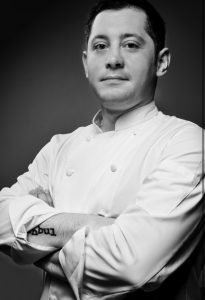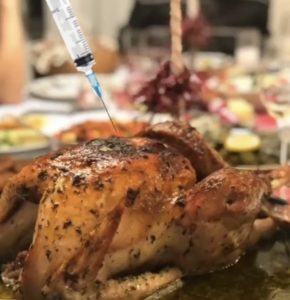After completing high school education at Lycée Saint-Benoit, I went to France to study Cookery and Restaurant Management at Institut Paul Bocuse in Lyon, and Hotel Management and Restaurant Management at L’Ecole Hoteliere d’Avignon in Avignon. I started my career at Le Sud (Paul Bocuse) in Lyon and continued at the two Michelin starred Le Pavillon de la Rotonde in Lyon. In 2009, after working at Alain Ducasse’s restaurant Le “58” Tour Eiffel in Paris, I moved to Chateau de Bagnols with a Michelin star. In 2012, I moved to Taiwan and worked as “Chef de Cuisine” at Longtable in Taipei. Then I worked at Restaurant André in Singapore, which has two Michelin stars and is 14th in The World’s 50 Best Restaurant list and 2nd in Asia’s 50 Best Restaurants list. Returning to Turkey in 2014, I took on the duties of “Chef de Cuisine” in various restaurants. In 2017, I successfully completed the Le Cordon Bleu Chef tests and joined the Le Cordon Bleu Istanbul instructor staff.
Throughout my career, I have experienced the cuisines of different countries in Asia and Europe. This is how my interest in American cuisine, which was born from the mixture of many different cultures, began. In the future, I will share different cuisines and food cultures of the world through ARTTMODERNMIAMI.
In my first post, I want to talk about Thanksgiving.
Undoubtedly, one of the most important holidays in the United States and Canada is Thanksgiving. Thanksgiving is a spiritual time to be thankful for nature’s blessings, a good harvest, and the good things that happened to us that year.
Being thankful for the harvest demonstrates the importance of food supply, which links Thanksgiving with eating and drinking.
So where is the gastronomy in that?
First of all, let me talk about where, how and why the gastronomic culture emerged.
The best and broadest definition I will make is gastronomy as the pleasure of eating/eating for pleasure. In other words, the person not only aims to fill his stomach, but also aims to eat hedonistically, in a ritual or in a meeting. This is a gastronomic approach to food. Consumption is not just for necessity. Food is loaded with values other than nutritional value. A drink can symbolize blood, while a pomegranate can symbolize fertility. A meal may have been attributed to a god. This will add a spiritual value to the meal. However, while preparing the meal, combining several different tastes and trying to catch another taste is seen as a quest beyond one’s desire to satisfy oneself. In addition, before eating the food, decorating it with different colors and putting it into different shapes adds artistic values to the food. This provides more than physical satisfaction.
Gastronomy is also to impose social values on food. It is known that this culture originated in Ancient Greece. At that time, people give banquets in large groups. The reason for this is sometimes to show gratitude to nature. Just like on Thanksgiving.
But the banquets back then were a little different. During these meals, which sometimes last for days, individuals who are full of stomach vomit and continue to eat. This is an indication that they eat food only for pleasure. Eating is not even in the fourth or fifth plan. This extreme indulgence brings with it the support of some feasts with sexual pleasure. These feasts, which are largely contrary to today’s moral rules, are the first events that gave birth to the gastronomic culture.
The habit of eating food in large groups inherited from these periods has become almost a necessity in some countries (especially Mediterranean countries) in the modern age. Namely: Southern France, Southern Spain, Italy etc. In countries, a person eating alone is invited to crowded tables in restaurants or cafes, or they are passed to this person’s table. Gastronomy can also be seen as an existential phenomenon that reduces the feeling of loneliness.
Although Thanksgiving could be considered as a day of gratitude to the harvest and nature centuries ago, we can say that this characteristic has decreased after the Industrial Revolution. I think it would be more accurate to say it’s a day of thanksgiving for the good things that year brought.
More importantly, we see that food unites people and that those who value each other come together around a table. I think the importance of Thanksgiving food is not just because it’s filling, of artistic value, or of taste, it’s that it acts as a magic key that brings people together. This is one of the most important reasons that make gastronomy beautiful.

Turkey Cooking Tips
I want to share with you a few tips for the turkey that is often cooked at Thanksgiving. It is not my purpose to describe. To mention a few tricks that you can apply to your own recipe.
First of all, the general judgment is that turkey meat is tough. This is partially true, but if you process the product as it should, it is possible to serve a soft turkey. There are 3 important stages to tenderize the turkey.
1. Putting the turkey in brine. There are many different recipes for this. There are 3 essential ingredients. Salt, vinegar and water. The rest of the spices (or sugar) is up to your taste. For a medium turkey, first place the turkey in a deep bowl. Put enough water to cover it. Add 1 cup of salt and 1/5 of the vinegar to the water. Mix it well. The turkey should be completely covered in a mixture of water, salt, and vinegar. Leave in brine for 24 hours. Then drain and dry thoroughly. This is the first step to tenderize turkey meat. Salt and acidity will soften the fibers in the meat.
2. Leave 6 pounds of butter at room temperature for 2 hours. Meanwhile, finely chop the fresh spices you have (parsley, fresh tarragon, fresh mint, fresh coriander, garlic) and mix them with butter. Since the butter is at room temperature, you will not have difficulty mixing it. After mixing well, spread the mixture over the entire surface of the turkey. Keep this in the refrigerator for at least 2 days. This resting will also make the meat tender.
3. Finally, after the turkey is cooked, let it rest for 45 minutes. During resting, inject the butter and fresh spice mixture that has flowed into the cooking tray with the help of a syringe into different parts of the breast and thigh of the turkey. The meat that has started to dry due to the heat will become soft and delicious again.
Enjoy your meal.
Alican Saygı
insatagram: @alican_saygi


